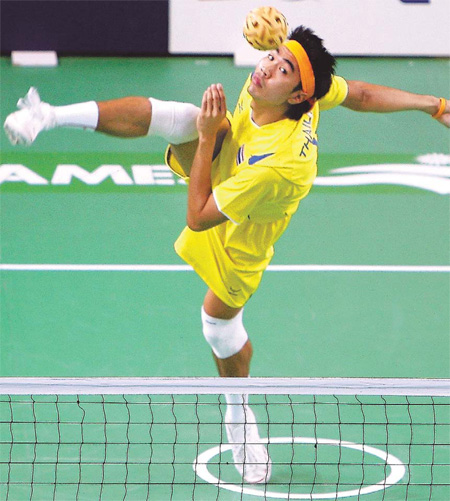
|
Drums set to beat for 'elastic' athletes
Both Thailand and Malaysia claim to have originated sepak takraw, and their rivalry is fierce in the highly skilled game. Whoever emerges victorious at the Asian Games will claim bragging rights for the next four years, meaning winning here is a high priority for the neighboring countries. The event gets underway on Monday with Myanmar and Indonesia also in the hunt, along with the Republic of Korea. The ROK has been pinpointed by Thailand manager Thavat Kumutpongpanich as a country that has made progress since the last games in Doha four years ago. "Malaysia is no longer our main rivals, having lost to Thailand in recent years with sub-standard performances," he told Thai media ahead of the games. "We cannot underestimate them," he added when asked about the Koreans. "We are well-prepared for the Asian Games after months of intensive training and we will try to win at least three gold medals." The Thais are defending men's champions and boast Suebsak Phunsueb among their ranks - arguably the finest male server in the sport's history and a household name at home. "I am not worried about my physical fitness but I must be fully fit mentally," said Suebsak, who has represented Thailand for 15 years and is competing at his fourth Asian Games. The sport, unique to the Asian Games, should spark plenty of interest in Guangzhou with its dazzling display of acrobatic twists, turns and body swerves. Even admirers of overhead kicking would be envious of the elasticity and agility of sepak takraw athletes, who basically play foot volleyball. Few of the locals in China will have seen anything like it, and the novelty is expected to attract crowds to the Haizhou Sports Center. Some diehard fans have even made the trek from Southeast Asia. Sepak takraw made its debut at the 1990 Asian Games in Beijing, where Malaysia won two gold medals. The sport is played on a court with a hand-woven ball (takraw) by teams made up of two or three people on each side. Points are scored by hitting the ball above the net and into the court as the opposing players attempt to "block". Kicks, often performed mid-air at shoulder height, form the basis of the game. No hands are allowed but feet, legs, shoulders and head can be used to keep the ball in play. Players routinely spike the ball, turning acrobatic somersault movements or bicycle kicks in mid-air to keep the ball in play. |
|
| Site Map | RSS | Newsletter | Work for Us Copyright © China.org.cn. All Rights Reserved 京ICP证 040089号 |
 0
0 








Go to Forum >>0 Comments